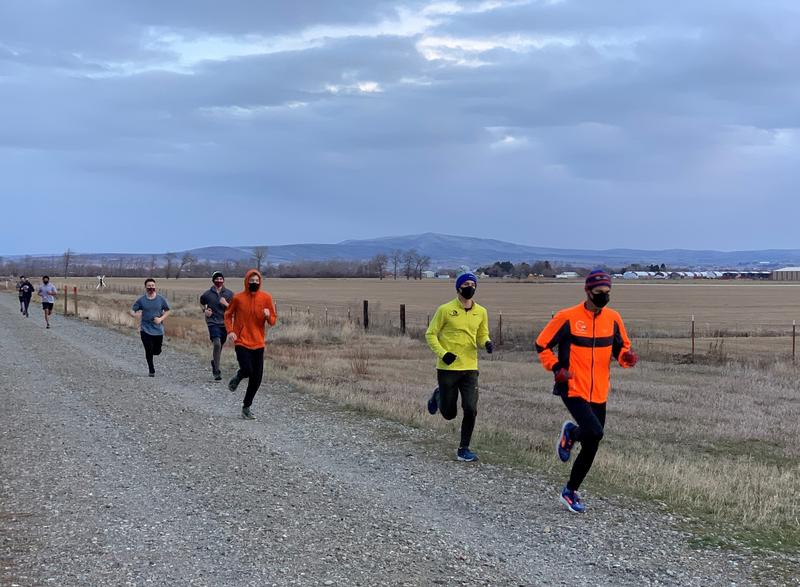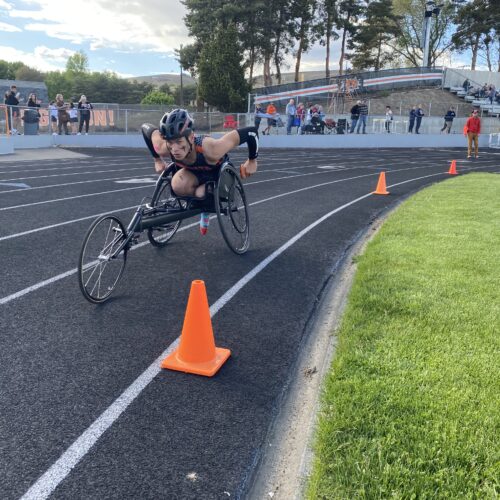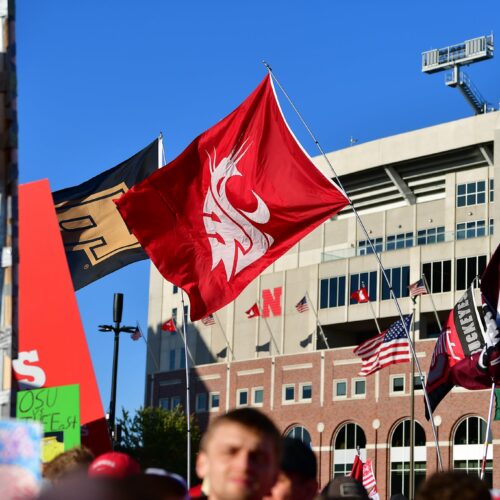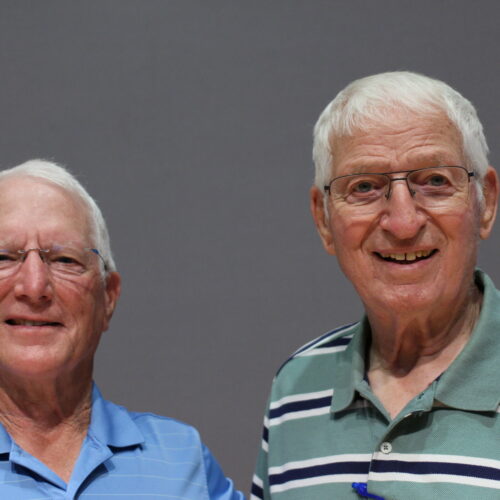
School Sports Make A Comeback In The Northwest, With Mask Rules Adding Level Of Difficulty
Listen
Rescheduled fall sports seasons for high school athletes are kicking off this month in large parts of Washington state and Oregon. The general happiness this brought came with a dose of consternation among some coaches and families over strict COVID-19 safety guidelines set down by state health authorities.
This week, cross-country runners and gymnasts in Washington received state permission to remove masks during competition. Otherwise, high school runners, footballers and soccer players must wear a face covering at all times.
Ellensburg High School cross-country coach Jeff Hashimoto lobbied for official clearance to lower masks during strenuous activity. Before explaining why, he wanted to underscore that he is not a COVID-19 rebel.
“I’m not anti-mask or anything like that,” Hashimoto said in an interview. “I really appreciate all the work that our public health officials have done and the governor.”
Hashimoto and fellow coaches in his conference struggled with a conundrum that everyday runners and other athletes can probably also relate to: When is it OK to pull down your face mask when exercising outdoors? And when should it stay up?
The state Department of Health guidelines for athletes to be masked at all times was fine during easy runs, Hashimoto said. But the coach worried his young runners might pass out in high-intensity workouts and racing.
ALSO SEE: New CDC Advice Recommends More Mask Protection
“When you run with a mask, that mask gets soaked in condensation,” Hashimoto said. “It gets increasingly harder to run with. I have seen kids exhibiting labored breathing, getting light-headed. I think it is a potentially dangerous situation.”
Hashimoto along with other Central Washington conference coaches and their state association worked the phones, emailed and even wrote a letter directly to the governor to ask for a little leeway. They showered their contacts with studies and citations.
At first, the Washington State Department of Health defended its always-on mask guidance. Deputy Health Secretary Lacy Fehrenbach said greenlighting more activities, like the resumption of school sports, required adding extra layers of protection in light of ongoing high rates of COVID-19 in the state and country.
“We understand that it is an adjustment to learn to do your sports or physical activity wearing a mask,” Fehrenbach said during a media briefing last week. “However, I can say anecdotally we have heard that this is going relatively well with the athletes. Most of the concerns that have been expressed to us have been from parents or coaches. The athletes themselves have done pretty well in adapting and adjusting to this change.”
But then this week, Washington state updated its guidance for sports activities. Now, cross-country runners can pull down their masks once they begin a race. Gymnasts can remove their masks for routines that involve flips or blind landings, where a slipped mask could be trouble.
The Washington Interscholastic Activities Association said it was able to show that in other states where these sports already finished their seasons, there were no documented cases of in-competition virus transmission.

Ellensburg High School cross country coach Jeff Hashimoto, right, and high school senior Bryton Wilson finish a masked training run in Ellensburg on Monday. CREDIT: Tom Banse/N3
“I know the cross-country coaches are celebrating. And gymnastics too,” said Justin Kesterson, WIAA assistant executive director.
As soon as Washington made the change, the Oregon School Activities Association sent the revised policy to the Oregon Health Authority and governor’s office to see if similar adjustments would be possible.
“When I got the information, I immediately passed it on,” said OSAA executive director Peter Weber, who added that Oregon parents and coaches had previously reached out with identical concerns about inhibited breathing during heavy exertion.
Cross-country meets will still look different amid the pandemic. Parents are supposed to watch from their cars. Staggered starts have replaced the traditional mass start and runners are told not to cluster in tight packs.
A few Washington high schools had threatened to boycott upcoming meets unless the rule about masks in competition was loosened. Ellensburg senior and boys cross-country captain Bryton Wilson said that was discussed at a recent team meeting. It’s now thankfully off the table.
ALSO SEE: New CDC Advice Recommends More Mask Protection
“I have done some races with a mask on,” Wilson said before practice Monday. “It’s definitely much harder and I’ve had asthma kick in.”
Fellow team captain Olivia Berthon-Koch said she was reluctant to boycott over the mask issue.
“It’s definitely not what I imagined my senior season being, but I’ll take what I can get at this point,” she said.
But isn’t there always something? A new hurdle to get to the starting line could be snow and frigid temperatures in the forecast beginning Thursday, which could delay X-C meets scheduled in the coming days.
Now that the controversy over masks has “melted,” Bainbridge High School head cross-country coach Anne Howard Lindquist said she hopes the focus can return to savoring how great it is to have competitive running back. In a message, Lindquist noted that her student athletes had been training since summer for a fall season that never happened. They resumed training in winter without knowing for sure whether and when the postponed season would be revived.
The condensed six or seven week 2020-21 high school cross-country season will lead directly into a similarly compact spring track and field season, beginning March 15 in Washington and April 5 in Oregon.
Related Stories:

Star Ephrata, Washington, graduate lost left leg but keeps on track toward his future
Ben Belino races the mile May 2 at Ephrata High School. The graduate had his left leg amputated after a bad car crash. The student plans to play wheelchair basketball

WSU alumni, students worry about the future of athletics after Pac-12 news
The Ol’ Crimson flag waves during an ESPN College GameDay. (Courtesy: Ol’ Crimson Booster Club) Listen (Runtime 0:50) Read Every ESPN College GameDay, somewhere in the crowd you can see

StoryCorps Northwest: Dick Deane & Jon Lane — School Struggles and Coaching Champions
What does it take to lead a championship-winning wrestling team? In this week’s StoryCorps Northwest, former coach Dick Deane talks to Jon Lane, a former student, about how Deane became a coach. Both are from Moses Lake.















